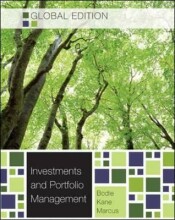Summary: Investments
- This + 400k other summaries
- A unique study and practice tool
- Never study anything twice again
- Get the grades you hope for
- 100% sure, 100% understanding
Read the summary and the most important questions on Investments
-
1 The investment environment
-
1.2 Financial assets
This is a preview. There are 3 more flashcards available for chapter 1.2
Show more cards here -
What are fixed-income or debt securities?
They promise either a fixed stream of income or a stream of income determined by a specified formula.
-
What are derivative securities?
Derivative securities such as options and futures contracts provide payoffs that are determined by the prices of other assets such as bond or stock prices. One use of derivatives, perhaps the primary use, is to hedge risks or transfer them to other parties.
-
What is the money market?
The money market refers to debt securities that are short term, highly marketable, and generally of very low risk
-
What is the capital market?
The fixed-income capital market includes long-term securities such as Treasury bonds. These bonds range from very safe in terms of default risk (for example, Treasury securities) to relatively risky (for example, high-yield or “junk” bonds).
-
1.3 Financial markets and the economy
This is a preview. There are 1 more flashcards available for chapter 1.3
Show more cards here -
What roles does financial markets have?
- The informational role of financial markets
- Consumption timing
- Allocation of risk
- Separation of ownership and management
-
What is the informational role of financial markets?
If a corporation seems to have good prospects for future profitability, investors will bid up its stock price. If, on the other hand, a company’s prospects seem poor, investors will bid down its stock price. The stock market encourages allocation of capital to those firms that appear at the time to have the best prospects.
-
What is consumption timing?
Shifting the purchasing power from high-earnings periods to low-earnings periods of life. Thus, financial markets allow individuals to separate decisions concerning current consumption from constraints that otherwise would be imposed by current earnings.
-
What is allocation of risk?
Financial markets and the diverse financial instruments traded in those markets allow investors with the greatest taste for risk to bear that risk, while other, less risk-tolerant individuals can, to a greater extent, stay on the sidelines.
This allocation of risk also benefits the firms that need to raise capital to finance their investments. When investors are able to select security types with the risk-return characteristics that best suit their preferences, each security can be sold for the best possible price.
-
What is separation of ownership and management?
The owners and managers of the firm are different parties. This gives the firm a stability that the owner-managed firm cannot achieve. For example, if some stockholders decide they no longer wish to hold shares in the firm, they can sell their shares to other investors, with no impact on the man- agement of the firm. Thus, financial assets and the ability to buy and sell those assets in the financial markets allow for easy separation of ownership and management.
-
1.4 The investment process
This is a preview. There are 2 more flashcards available for chapter 1.4
Show more cards here -
What is the asset allocation decision?
The asset allocation decision is the choice among these broad asset classes. Asset allocation also includes the decision of how much of one’s portfolio to place in safe assets such as bank accounts or money market securities versus in risky assets.
- Higher grades + faster learning
- Never study anything twice
- 100% sure, 100% understanding
Topics related to Summary: Investments
-
The investment environment - The players
-
Asset classes and financial instruments - The money market
-
Asset classes and financial instruments - The bond market
-
Asset classes and financial instruments - Equity securities
-
Asset classes and financial instruments - Stock and bond market indexes
-
How securities are traded - How firms issue securities
-
How securities are traded - U.S. securities markets
-
How securities are traded - Short sales
-
Mutual funds and other investment companies - Types of investment companies
-
Mutual funds and other investment companies - Mutual funds
-
Mutual funds and other investment companies - Cost of investing in mutual funds
-
Introduction to risk, return and the historical record
-
Risk aversion and capital allocation to risky assets
-
Index models - A single-factor security market
-
Index models - The single index model
-
Index models - Estimating the single-index model
-
Index models - Portfolio construction and the single index model






























